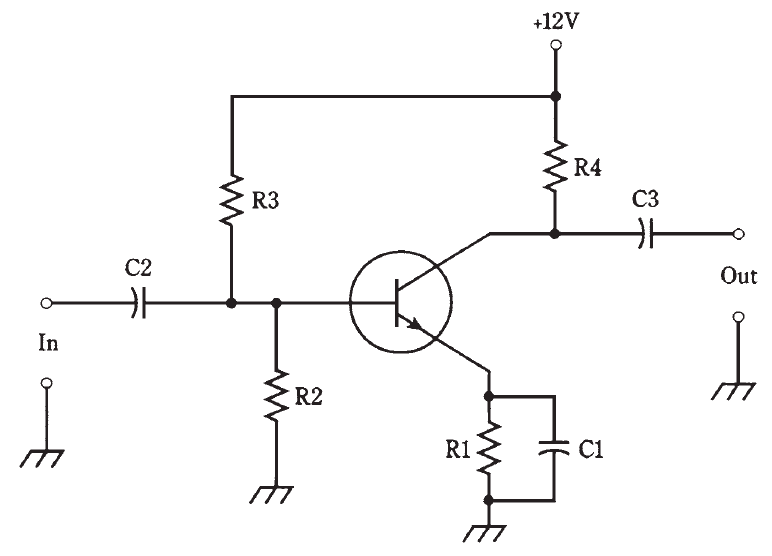


 الفيزياء الكلاسيكية
الفيزياء الكلاسيكية
 الكهربائية والمغناطيسية
الكهربائية والمغناطيسية
 علم البصريات
علم البصريات
 الفيزياء الحديثة
الفيزياء الحديثة
 النظرية النسبية
النظرية النسبية
 الفيزياء النووية
الفيزياء النووية
 فيزياء الحالة الصلبة
فيزياء الحالة الصلبة
 الليزر
الليزر
 علم الفلك
علم الفلك
 المجموعة الشمسية
المجموعة الشمسية
 الطاقة البديلة
الطاقة البديلة
 الفيزياء والعلوم الأخرى
الفيزياء والعلوم الأخرى
 مواضيع عامة في الفيزياء
مواضيع عامة في الفيزياء|
Read More
Date: 7-4-2021
Date: 28-4-2021
Date: 29-3-2021
|
Common emitter circuit
A transistor can be hooked up in three general ways. The emitter can be grounded for signal, the base can be grounded for signal, or the collector can be grounded for signal. Probably the most often-used arrangement is the common-emitter circuit. “Common” means “grounded for the signal.” The basic configuration is shown in Fig. 1.
A terminal can be at ground potential for the signal, and yet have a significant dc voltage. In the circuit shown, C1 looks like a dead short to the ac signal, so the emitter is at signal ground. But R1 causes the emitter to have a certain positive dc voltage with respect to ground (or a negative voltage, if a PNP transistor is used). The exact dc voltage at the emitter depends on the value of R1, and on the bias.

Fig. 1: Common-emitter circuit configuration.
The bias is set by the ratio of resistances R2 and R3. It can be anything from zero, or ground potential, to + 12 V, the supply voltage. Normally it will be a couple of volts. Capacitors C2 and C3 block dc to or from the input and output circuitry (whatever that might be) while letting the ac signal pass. Resistor R4 keeps the output signal from being shorted out through the power supply.
A signal voltage enters the common-emitter circuit through C2, where it causes the base current, IB to vary. The small fluctuations in IB cause large changes in the collector current, IC. This current passes through R4, causing a fluctuating dc voltage to appear across this resistor. The ac part of this passes unhindered through C3 to the output.
The circuit of Fig. 1 is the basis for many amplifiers, from audio frequencies through ultra-high radio frequencies. The common-emitter configuration produces the largest gain of any arrangement. The output is 180 degrees out of phase with the input.



|
|
|
|
دخلت غرفة فنسيت ماذا تريد من داخلها.. خبير يفسر الحالة
|
|
|
|
|
|
|
ثورة طبية.. ابتكار أصغر جهاز لتنظيم ضربات القلب في العالم
|
|
|
|
|
|
|
قسم الشؤون الفكرية يعزز مكتبته بفهارس المخطوطات التركية
|
|
|